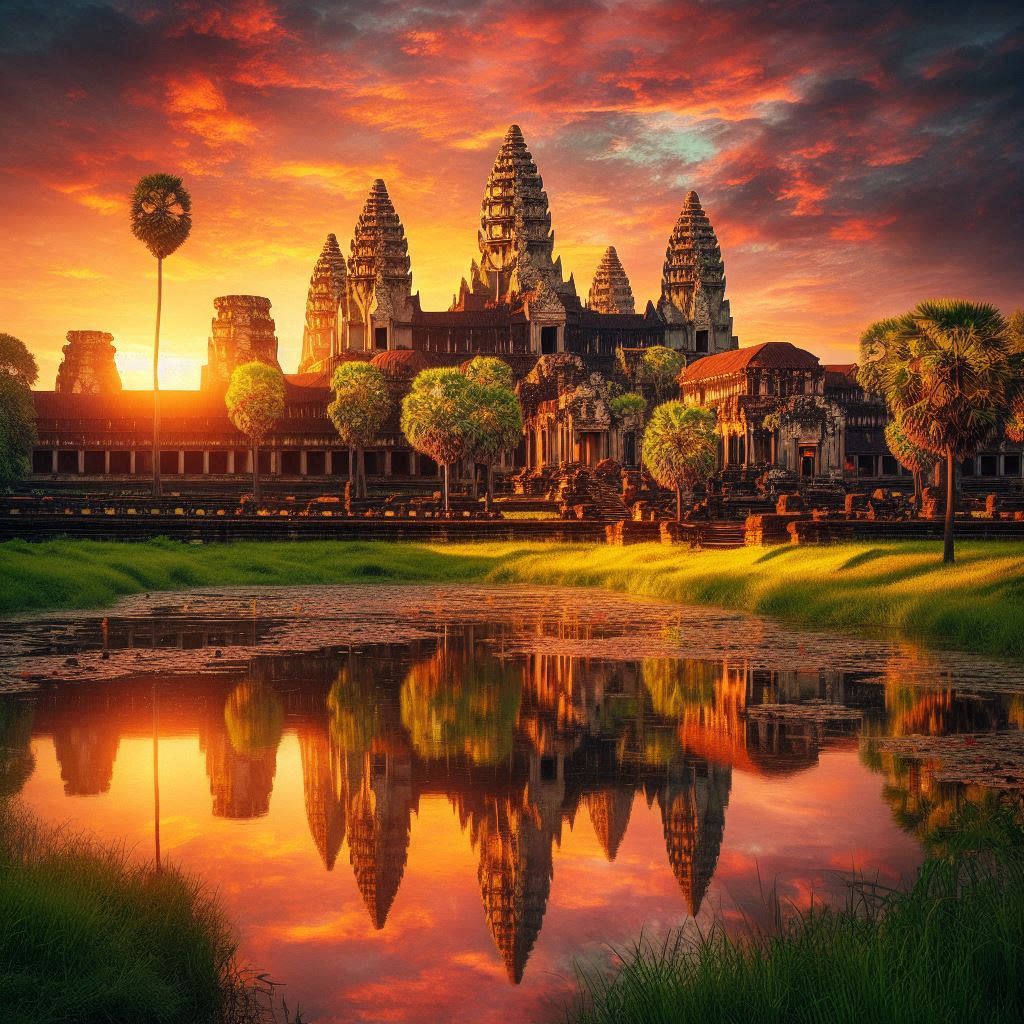Nestled in the lush landscapes of Siem Reap, Cambodia, Angkor Wat is one of the most iconic and breathtaking monuments in the world. As the largest religious structure on Earth, this UNESCO World Heritage Site is a testament to the ingenuity, artistry, and devotion of the Khmer Empire. A visit to Angkor Wat is a journey through time, offering an unforgettable experience of Cambodia’s rich history and cultural heritage.
The History of Angkor Wat

Built in the early 12th century during the reign of King Suryavarman II, Angkor Wat was originally dedicated to the Hindu god Vishnu. Over the centuries, it transitioned into a Buddhist temple, reflecting Cambodia’s shift in religious practices.
The name “Angkor Wat” translates to “City of Temples”, symbolizing its grandeur and spiritual significance. It served as both a religious center and a political hub of the Khmer Empire, which was one of Southeast Asia’s most powerful civilizations.
Angkor Wat Architectural Marvel
Angkor Wat is a masterpiece of Khmer architecture, combining intricate artistry with advanced engineering techniques. The temple complex covers approximately 162 hectares (400 acres) and features an awe-inspiring array of structures, carvings, and symbolic designs.
Key Features
- Central Tower and Layout
- Angkor Wat is designed as a microcosm of the Hindu universe. The central tower represents Mount Meru, the home of the gods, while the surrounding moats and walls symbolize the cosmic ocean and mountain ranges.
- Intricate Bas-Reliefs
- The walls of Angkor Wat are adorned with extensive bas-reliefs, depicting scenes from Hindu epics like the Ramayana and the Mahabharata, as well as historical events. The Churning of the Ocean of Milk is one of the most famous panels.
- Symmetry and Harmony
- The temple’s layout reflects perfect symmetry and harmony, with its towering spires rising gracefully above the complex.
- Moat and Reflection
- The surrounding moat not only served as a defensive feature but also enhances the temple’s aesthetic, creating stunning reflections during sunrise and sunset.
Best Times to Visit Angkor Wat

Angkor Wat is a magical destination at any time of day, but certain moments stand out:
- Sunrise: Witnessing the sun rise behind the central spires of Angkor Wat is an unforgettable experience. The soft hues of dawn create a surreal and serene atmosphere.
- Sunset: As the day ends, the golden light bathes the temple, highlighting its intricate carvings and grandeur.
The best months to visit are during the cool dry season (November to February), when the weather is more comfortable for exploring the vast complex.
Exploring the Angkor Complex

Angkor Wat is just one part of the larger Angkor Archaeological Park, which is home to dozens of other remarkable temples and sites:
- Bayon Temple
- Famous for its massive stone faces, Bayon represents the intersection of the divine and human realms.
- Ta Prohm
- Known as the “Tomb Raider Temple,” Ta Prohm is enveloped by giant tree roots, creating an ethereal and mysterious ambiance.
- Banteay Srei
- Often called the “Citadel of Women,” this temple is renowned for its intricate pink sandstone carvings.
- Angkor Thom
- The great city of Angkor Thom, with its imposing gates and iconic structures, showcases the might of the Khmer Empire.
Tips for Visiting Angkor Wat

- Buy a Pass
- Entry requires an Angkor Pass, which can be purchased for 1, 3, or 7 days, depending on how much time you plan to spend exploring the park.
- Start Early
- To beat the heat and the crowds, begin your day at sunrise.
- Dress Modestly
- As Angkor Wat is a sacred site, wear clothing that covers your shoulders and knees.
- Hire a Guide or Tuk-Tuk Driver
- A knowledgeable guide can provide insights into the history and significance of the temples, while a tuk-tuk driver can help you navigate the sprawling complex. Book your spot.
- Stay Hydrated
- The Cambodian heat can be intense, so bring water and wear a hat or sunscreen.
Nearby Attractions
While Angkor Wat is the centerpiece, the Siem Reap area offers other attractions to enhance your visit:
- Angkor National Museum: Learn about the history and culture of the Khmer Empire.
- Tonle Sap Lake: Explore the floating villages and vibrant ecosystems of Southeast Asia’s largest freshwater lake.
- Phare Circus: Enjoy an evening of acrobatics and storytelling at this unique cultural performance.
Why Visit Angkor Wat?

Angkor Wat is more than just a historical site—it is a living testament to the brilliance of human creativity and spirituality. Walking through its ancient corridors, marveling at its detailed carvings, and standing before its towering spires is a humbling and awe-inspiring experience.
- Architectural Masterpiece: Admire one of the world’s most impressive examples of ancient architecture.
- Historical Significance: Explore a UNESCO World Heritage Site that reflects the grandeur of the Khmer Empire.
- Cultural Immersion: Learn about Khmer culture, mythology, and religious beliefs.
- Photographic Opportunities: Capture stunning photos of the temple’s intricate details and iconic silhouette.
A visit to Angkor Wat is not just a journey into Cambodia’s past but a chance to connect with a legacy that continues to inspire millions around the world.
Have you visited Angkor Wat? Share your experiences in the comments below!








0 Comment